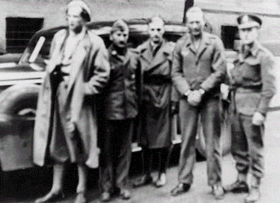Siegfried Fehmer

Siegfried Wolfgang Fehmer (10 January 1911 in München – 16 March 1948) was a German Gestapo officer during World War II. He was stationed in Norway during the occupation of Norway by Nazi Germany, and at the end of the war he was a Kriminalrat, the police investigator heading the infamous Abteilung IV from its headquarters in Victoria Terrasse, Oslo. He had also reached the rank of Hauptsturmführer in the SS. Along with Josef Terboven, Fehmer was considered one of the most despised members of the German occupation forces in Norway.
History
Fehmer joined the National Socialist German Workers Party in January 1930 and was employed by the Gestapo from 1934. He was promoted several times and held different positions within the organization, until in April 1940 he was sent to Norway. There he worked with counter-intelligence and suppressing the resistance.
Fehmer wore an SS uniform with Sicherheitsdienst badges. The Sicherheitsdienst (SD, Security Service) was primarily the intelligence service of the SS and the Nazi Party in Nazi Germany. With a striking appearance and charm, he was perceived as quite the ladies man. Despite this outward appearance, Fehmer was ruthless, and did not hesitate to use torture during interrogation of suspects. He has been described by his victims as capable of switching from using a friendly approach to sadistic torture in a heartbeat.
Milorg (the military branch of the Norwegian resistance movement) saw him as a severe threat. Several plans for his assassination were made, and Fehmer survived one such attack with several gunshot wounds to his chest.
At the end of the war, on 8 May 1945, Fehmer attempted to escape to Sweden, but was apprehended by Sergeant John Maclean (later Second Lieutenant) from British Military Intelligence, assisted by Norwegian police officers, near the border. Throughout the war Fehmer had used his pet German shepherd to torture his victims, and Maclean realised that Fehmer would attempt to retrieve his dog before leaving Norway. Through interrogation of some of Fehmer's associates Maclean discovered the location of the dog, where he waited until Fehmer duly appeared. Fehmer was tried and convicted of war crimes, and sentenced to death by the Supreme Court of Norway. The sentence was carried out by firing squad at Akershus Fortress on 16 March 1948.
In pop culture
One of the main characters in the 2008 Norwegian film Max Manus, he was portrayed by the German actor Ken Duken.
External links
- Photograph
- Siegfried Fehmer at the Norsk biografisk leksikon. (In Norwegian.)